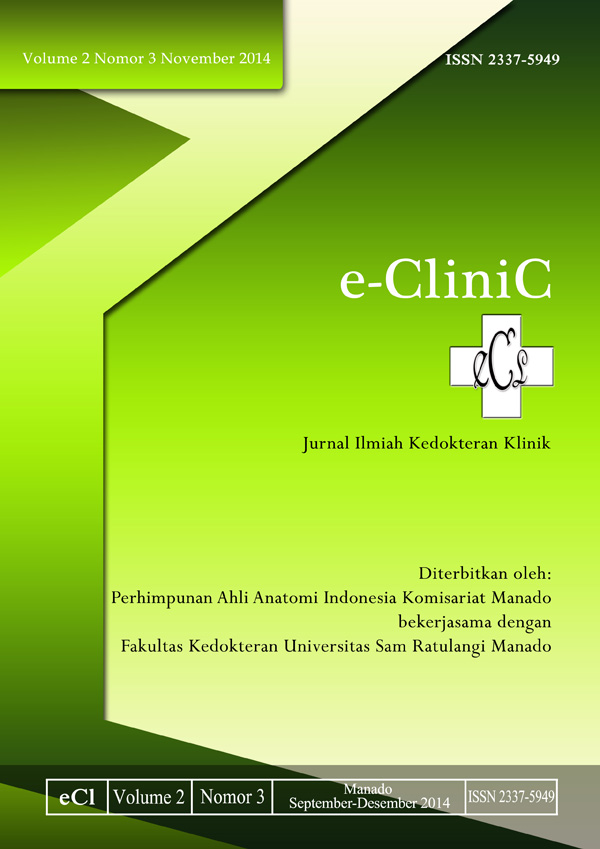HUBUNGAN PRODUK Ca x P DENGAN KADAR C-TERMINAL CROSS LINKING TELOPEPTIDE TYPE I COLLAGEN PADA SUBJEK PENYAKIT GINJAL KRONIK YANG MENJALANI HEMODIALISA RUTIN
DOI:
https://doi.org/10.35790/ecl.v2i3.5744Abstract
Abstrak: Penyakit Ginjal Kronik (PGK) merupakan masalah kesehatan yang telah mencakup seluruh masyarakat dunia dan berdampak pada jutaan orang dari seluruh ras dan etnis yang terjadi ketika kondisi fungsi ginjal mengalami gangguan dan hemodialisis merupakan terapi pengganti ginjal yang umum dilakukan. Ketidakseimbangan elektrolit (kalsium dan fosfat) di dalam tubuh akan berlangsung terus menerus dan irreversible pada PGK. CTX adalah biomarker serum yang digunakan untuk mengukur tingkat regenerasi tulang. Tujuan: Penelitian ini bertujuan untuk mengetahui hubungan produk Ca x P dengan kadar CTX pada subjek PGK yang menjalani hemodialisis rutin. Metode: Penelitian ini bersifat deskriptif/analitik dengan rancangan potong lintang. Data diolah dengan cara disusun dalam bentuk tabel dan grafik. Hasil: Dari penelitian ini tampak bahwa seluruh responden memiliki kadar CTX lebih diatas normal yaitu sebanyak 20 orang (100 %). Pada frekuensi hemodialisa yang dilakukan antara 192 – 239 x dan 288 – 335 x paling banyak ditemukan masing-masing sebanyak 6 orang (30%) dan pada frekuensi hemodialisa yang dilakukan antara 240 – 287 x sebanyak 5 orang (25%) diikuti frekuensi HD > 336 x sebanyak 3 orang (15%) yang terdiri dari 1 laki-laki (5%) dan 2 perempuan (10%). Simpulan: Rata-rata nilai serum kalsium pada subjek penyakit ginjal kronik yang menjalani hemodialisis rutin adalah 7,96 mg/dl. Rata-rata nilai serum fosfat pada subjek penyakit ginjal kronik yang menjalani hemodialisis rutin adalah 7,26 mg/dl. Terdapat hubungan positif hasil produk CaP dengan kadar CTX, walaupun secara statistik tidak bermakna.
Kata kunci: Kalsium serum, Fosfat serum, CTX, PGK, Hemodialisis
Â
Â
Abstract: Chronic kidney disease (CKD) is a health concern that covered everyone in the world and affected millions of people from various race and ethnics in which the kidney did not functioning properly thus hemodialysis is a kidney replacement therapy which often performed. There will always be electrolite imbalance (Calcium and phosphat) in the body and this is irreversible in CKD. CTX is a serum biomarker that has been used to measure bone regeneration rate. Objectives: This study aims to asses the relation between Ca x P product and CTX level on CKD subjects who undergo routine hemodialysis. Methods: This study is a descriptive/ analysis study using a cross link design. Data processing was done by using table and charts. Results: From this study we found that all of the respondent who have an above normal CTX level are 20 people (100%). Hemodialysis frequency that have been done is between 192-239 times and 288-335 times which is the most frequent among 6 people (30%) and on hemodialysis frequency that have been done between 240-287 times on 5 people (25) followed by HD frequency >336 times on 3 people (15%); 1 male (5%) and 2 female (10%). Conclusions: The value of mean calcium serum on subjects with CKD who undergo routine hemodialysis is 7,96 mg/dL. Value of mean phosphat serum on subjects with CKD who undergo routine hemodialysis is 7,26 mg/dL. We found that there is a positive relationship between CaP product and CTX level, although not significant statistically.
Keywords: serum calcium, serum phosphat, CTX, CKD, hemodialysis
Downloads
How to Cite
Issue
Section
License
COPYRIGHT
Authors who publish with this journal agree to the following terms:
Authors hold their copyright and grant this journal the privilege of first publication, with the work simultaneously licensed under a Creative Commons Attribution License that permits others to impart the work with an acknowledgment of the work's origin and initial publication by this journal.
Authors can enter into separate or additional contractual arrangements for the non-exclusive distribution of the journal's published version of the work (for example, post it to an institutional repository or publish it in a book), with an acknowledgment of its underlying publication in this journal.
Authors are permitted and encouraged to post their work online (for example, in institutional repositories or on their website) as it can lead to productive exchanges, as well as earlier and greater citation of the published work (See The Effect of Open Access).







